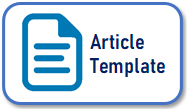Komunitas Makrozoobentos di Sungai Gua Pintu Ngalau pada Kawasan Karst di Sumatera Barat
Abstract
Pintu Ngalau cave is flowed by river from irrigated rice fields that flows into the cave. This cave has a source of organic matter derived from bats and swallow dirts, litter that falls on enterance of the cave and the organic material carried by the flow of the river. The study on the macrozoobenthos communities of river in Pintu Ngalau Cave has been conducted from October until November 2016. The study used survey method, where stratified random sampling was applied in three zones (light zone, dim zone and dark zone) at study site. Macrozoobenthos samples was collected by surber net. This study also measured the physic-chemical of water. The results showed the composition of macrozoobenthos in the Pintu Ngalau cave river consisted of 43 genera i.e Gastropods (2 genera), Hirudinea (2 genera), Insects (36 genera) and Oligochaetas (3 genera). Total density of macrozoobenthos in this site was 2100 ind/m2 and the highest density was found in dark zone. The highest total relative density (KR total=79,89%) on genus level at every zone was Hydropsyche. Diversity index of macrozoobenthos was classified as medium (H'=2.68) with evenness distribution was evenly (E=0.61) and no dominant genus (C=0.14). The existence of macrozoobenthos was not influenced by light intensity, but instead was more influence by the condition of the substrate and the flow of water in the cave.
Keywords
Full Text:
PDFReferences
Abdurahman, O. 2015. Perspektif Pengelolaan Karst yang Berkelanjutan. Geomagz (Majalah Geologi Populer).5(1):2-3.
Barus, T.A. 2002. Limnologi. Jurusan Biologi FMIPA. USU. Medan.
Effendi, H. 2003. Telaah Kualitas Air Bagi Pengelolaan Sumber Daya dan Lingkungan Perairan. Kansius. Yogyakarta.
Izmiarti. 2010. Komunitas Makrozoobentos di Banda Bakali Kota Padang. Jurnal Biospectrum.6 (1) : 34 - 40.
Izmiarti, Nofrita, J. Nurdin dan H. Mar’i. 2016. Eksplorasi Komunitas Hidrobiota Sungai Di Dalam Gua Batu Asahan Kenagarian Sisawah Kecamatan Sumpur Kudus Kabupaten Sijunjung Sumatera Barat. Laporan Penelitian Mandiri FMIPA. Padang.
Kamal. M., I. Yustian dan S. Rahayu. 2011. Keanekaragaman Jenis Arthopoda di Gua Putri dan Gua Selebe Kawasan Karts Padang Bindu, UKO Sumatera Selatan. Jurnal Penelitian Sains.14 (1): 33-37.
Kendeight, S.C. 1980. Ecology With Special Reference to Animal and Man. Prentice Hall of India. Primate Limited. New Delhi.
Merrit, R.W dan K. W. Cummins. 1984. An Introduction to The Aquatic Insects of North America. Edisi 2. Kendall Hunt Publishing Company. USA.
Odum, P. E. 1998. Dasar-Dasar Ekologi. Edisi Ketiga. Diterjemahkan oleh Tjahjono Samingan. Edisi Ketiga. Gajah Mada University Press. Yogyakarta.
Pennak, R. W. 1978. Freshwater Invertebrates of United States. 2nd. Ed. Willey Interscience Publ. John Willey and Sons. New York.
Peraturan Pemerintah Republik Indonesia Nomor 82 Tahun 2001 tentang Pengelolaan Kualitas Air dan Pengendalian Pencemaran Air.
Rahmadi, C. 2005. Menyikap Ekosistem Karst Maros. Koran Tempo. Edisi 5 September 2005.
Rondo, M. 1982. Hewan Bentos Sebagai Indikator Ekologi Di Sungai Cikapundung, Bandung. Tesis Pasca Sarjana. Institut Teknologi Bandung. Bandung
Suhendar, R. 2015. Kebijakan Pengelolaan Karst di Indonesia. Geomagz (Majalah Geologi Populer).5(1):18-19.
Suin, M. N. 2002. Metoda Ekologi. Universitas Andalas. Padang
Refbacks
- There are currently no refbacks.




